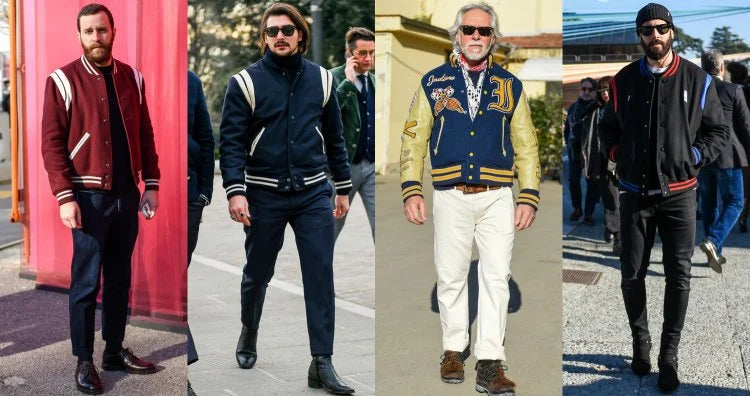"Sutajan" is short for "Stadium Jumper" and is a Japanese-coined English term. It was named by the fashion icon Kenzaki Ishitsu, famous for VAN. In English, it's referred to as "Award Jacket," "Varsity Jacket," "Letterman Jacket," and other names.
Its origin lies in American baseball. It began as a jacket with leather sleeves worn over players' uniforms to keep the pitchers' shoulders warm during standby. This unique jacket quickly spread from the same baseball club to high schools and colleges across North America. The bold two-tone color combination of wool body and leather sleeves made it a highly eye-catching jacket. Gradually, it found its way into club activities other than baseball and became a prominent cheering outfit during matches.
These jackets were personalized by attaching a single-letter chenille (fuzzy) patch, representing the school name, team name, or mascot, to the left chest, using school colors for the body. Decorating both arms, the back, and the right chest with one's position number, graduation year, and mascot became customary. Moreover, if individuals achieved outstanding results in sports or competitions, they could freely add additional decorations. Over time, these jackets became akin to medals and were objects of envy among other members.
The terms "Award" and "Varsity" find their origins here. These jackets are a symbol of excellence, worn only by those selected and those with outstanding achievements. With wool bodies and leather sleeves, these jackets were prized then as they are now, commanding high prices. Additionally, they were embraced as outerwear due to their excellent insulation properties. The prominent two-tone color design made them fashionable items, visible in various city scenes.
Now, what is a "Sukajan"?
"Sukajan" is short for "Yokosuka Jumper" and is a Japanese-coined English term. In English, it's referred to as a "Souvenir Jacket." Shortly after the end of World War II, the Korean War began. Many young servicemen from the United States were stationed in Yokosuka, where U.S. military bases were established. They spent a certain period in Yokosuka before being deployed to the Korean Peninsula and returning afterward.

During their stay at Yokosuka base, one soldier decided to embroider the standard-issue nylon military jacket, intending to create a memento of their time in Japan. This idea caught on, and various embroidered patterns emerged, often inspired by Japanese and Eastern themes. This is why many "Sukajan" jackets feature intricate embroidery inspired by Japan. The term "Souvenir" refers to their origin as keepsake items.

Nylon military jackets have orange-colored linings to increase visibility in case of crashes or water landings during flights, helping rescuers locate them quickly. The orange lining is designed for wearing the jacket inside out during emergencies. This is why many "Sukajan" jackets are reversible, similar to the MA-1 bomber jacket.

Sukajan Vs. Sutajan
Knowing the history and functionality of each jacket type can certainly foster a deeper attachment to them.
